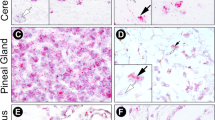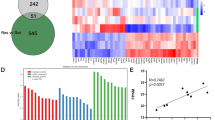Abstract
Deficient levels of serotonin are associated with suicide and depression. Paradoxically, in the dorsal raphe nucleus (DRN) there are more serotonin neurons and more neuronal tryptophan hydroxylase-2 (TPH2) expression postmortem in depressed suicides. In this study, we sought to determine whether greater TPH2 expression in depressed suicides was the result of more TPH2 expression per neuron. In situ hybridization and computer-assisted image analysis were performed on tissue sections throughout the extent of the raphe nuclei at the level of silver grains per neuron to systematically quantify TPH2 neuronal expression. Depressed suicides have 26.5% more TPH2 grain density per neuron in the DRN compared with matched controls (P=0.04). The difference in grain density is greater at mid- and caudal anatomical levels across the rostrocaudal axis of the DRN. Densitometric analysis of TPH2 expression in the DRN subnuclei showed that higher expression levels were observed at posterior anatomical levels of depressed suicides (121% of control in the caudal subnucleus). Higher TPH2 expression in depressed suicides may explain more TPH2 protein and reflect a homeostatic response to deficient serotonin levels in the brains of depressed suicides. Localized changes in TPH2 expression in specific subnuclei of the DRN suggest that the serotonergic compensatory mechanism in depression and suicide is specifically regulated within the DRN and has implications for regions innervated by this subnucleus.
This is a preview of subscription content, access via your institution
Access options
Subscribe to this journal
Receive 12 print issues and online access
$259.00 per year
only $21.58 per issue
Buy this article
- Purchase on Springer Link
- Instant access to full article PDF
Prices may be subject to local taxes which are calculated during checkout




Similar content being viewed by others
References
Mann JJ, Malone KM . Cerebrospinal fluid amines and higher-lethality suicide attempts in depressed inpatients. Biol Psychiatry 1997; 41: 162–171.
Mann JJ, McBride PA, Malone KM, DeMeo MD, Keilp JG . Blunted serotonergic responsivity in depressed patients. Neuropsychopharmacology 1995; 13: 53–64.
Pandey GN . Altered serotonin function in suicide. Evidence from platelet and neuroendocrine studies. Ann NY Acad Sci 1997; 836: 182–200.
Corrêa H, Duval F, Mokrani M-C, Bailey P, Trémeau F, Staner L et al. Prolactin response to D-fenfluramine and suicidal behavior in depressed patients. Psychiatry Res 2000; 93: 189–199.
Malone KM, Corbitt EM, Li S, Mann JJ . Prolactin response to fenfluramine and suicide attempt lethality in major depression. Br J Psychiatry 1996; 168: 324–329.
Weiss D, Coccaro EF . Neuroendocrine challenge studies of suicidal behavior. Psychiatr Clin North Am 1997; 20: 563–579.
Dulchin MC, Oquendo MA, Malone KM, Ellis SP, Li S, Mann JJ . Prolactin response to dl-fenfluramine challenge before and after treatment with paroxetine. Neuropsychopharmacology 2001; 25: 395–401.
Törk I, Hornung J-P . Raphe nuclei and the serotonergic system. In: Paxinos G (ed). The Human Nervous System. Academic Press: San Diego, 1990, pp 1001–1022.
Mann JJ . Neurobiology of suicidal behaviour. Nat Rev Neurosci 2003; 4: 819–828.
Mockus SM, Vrana KE . Advances in the molecular characterization of tryptophan hydroxylase (Review). J Mol Neurosci 1998; 10: 163–179.
Patel PD, Pontrello C, Burke S . Robust and tissue-specific expression of TPH2 versus TPH1 in rat raphe and pineal gland. Biol Psychiatry 2004; 55: 428–433.
Zhang X, Beaulieu JM, Sotnikova TD, Gainetdinov RR, Caron MG . Tryptophan hydroxylase-2 controls brain serotonin synthesis. Science 2004; 305: 217.
Bach-Mizrachi H, Underwood MD, Kassir SA, Bakalian MJ, Sibille E, Tamir H et al. Neuronal tryptophan hydroxylase mRNA expression in the human dorsal and median raphe nuclei: major depression and suicide. Neuropsychopharmacology 2006; 31: 814–824.
Underwood MD, Khaibulina AA, Ellis SP, Moran A, Rice PM, Mann JJ et al. Morphometry of the dorsal raphe nucleus serotonergic neurons in suicide victims. Biol Psychiatry 1999; 46: 473–483.
Boldrini M, Underwood MD, Mann JJ, Arango V . More tryptophan hydroxylase in the brainstem dorsal raphe nucleus in depressed suicides. Brain Res 2005; 1041: 19–28.
Bonkale WL, Turecki G, Austin MC . Increased tryptophan hydroxylase immunoreactivity in the dorsal raphe nucleus of alcohol-dependent, depressed suicide subjects is restricted to the dorsal subnucleus. Synapse 2006; 60: 81–85.
Bonkale WL, Murdock S, Janosky JE, Austin MC . Normal levels of tryptophan hydroxylase immunoreactivity in the dorsal raphe of depressed suicide victims. J Neurochem 2004; 88: 958–964.
Mann JJ, Huang YY, Underwood MD, Kassir SA, Oppenheim S, Kelly TM et al. A serotonin transporter gene promoter polymorphism (5-HTTLPR) and prefrontal cortical binding in major depression and suicide. Arch Gen Psychiatry 2000; 57: 729–738.
First MB, Spitzer RL, Gibbon M, Williams JMG, Benjamin L . Structured Clinical Interview for DSM-IV Axis II Personality Disorders (SCID-II) (Version 2.0). Biometrics Research Department, New York State Psychiatric Institute: New York, 1996.
Spitzer RL, Williams JBW, Gibbon M, First MB . The structured clinical interview for DSM-III-R (SCID). I: history, rationale, and description. Arch Gen Psychiatry 1992; 49: 624–629.
Williams JBW, Gibbon M, First MB, Spitzer RL, Davies M, Borus J et al. The structured clinical interview for DSM-III-R (SCID). II. Multisite test-retest reliability. Arch Gen Psychiatry 1992; 49: 630–636.
Kelly TM, Mann JJ . Validity of DSM-III-R diagnosis by psychological autopsy: a comparison with clinician ante-mortem diagnosis. Acta Psychiatr Scand 1996; 94: 337–343.
Arango V, Underwood MD, Boldrini M, Tamir H, Kassir SA, Hsiung S et al. Serotonin 1A receptors, serotonin transporter binding and serotonin transporter mRNA expression in the brainstem of depressed suicide victims. Neuropsychopharmacology 2001; 25: 892–903.
Harrison PJ, Heath PR, Eastwood SL, Burnet PWJ, McDonald B, Pearson RCA . The relative importance of premortem acidosis and postmortem interval for human brain gene expression studies: selective mRNA vulnerability and comparison with their encoded proteins. Neurosci Lett 1995; 200: 151–154.
Volk DW, Austin MC, Pierri JN, Sampson AR, Lewis DA . Decreased glutamic acid decarboxylase 67 messenger RNA expression in a subset of prefrontal cortical gamma-aminobutyric acid neurons in subjects with schizophrenia. Arch Gen Psychiatry 2000; 57: 237–245.
Gerfen CR, McGinty JF, Young III WS . Dopamine differentially regulates dynorphin, substance P, and enkephalin expression in striatal neurons: in situ hybridization histochemical analysis. J Neurosci 1991; 11: 1016–1031.
Placidi GP, Oquendo MA, Malone KM, Huang YY, Ellis SP, Mann JJ . Aggressivity, suicide attempts, and depression: relationship to cerebrospinal fluid monoamine metabolite levels. Biol Psychiatry 2001; 50: 783–791.
Zhang X, Gainetdinov RR, Beaulieu JM, Sotnikova TD, Burch LH, Williams RB et al. Loss-of-function mutation in tryptophan hydroxylase-2 identified in unipolar major depression. Neuron 2005; 45: 11–16.
Blakely RD . Overview: a rare opportunity or just one less reason to be depressed. Neuron 2005; 48: 701–702.
Glatt CE, Carlson E, Taylor TR, Risch N, Reus VI, Schaefer CA . Response to Zhang et al. (2005): loss-of-function mutation in tryptophan hydroxylase-2 identified in unipolar major depression. Neuron 45, 11–16. Neuron 2005; 48: 704–705.
Zhou Z, Peters EJ, Hamilton SP, McMahon F, Thomas C, McGrath PJ et al. Response to Zhang et al. (2005): loss-of-function mutation in tryptophan hydroxylase-2 identified in unipolar major depression. Neuron 45, 11–16. Neuron 2005; 48: 702–703.
Van Den BA, De ZS, Heyrman L, Mendlewicz J, Adolfsson R, Van BC et al. Response to Zhang et al. (2005): loss-of-function mutation in tryptophan hydroxylase-2 identified in unipolar major depression. Neuron 45, 11–16. Neuron 2005; 48: 704–706.
Delorme R, Durand CM, Betancur C, Wagner M, Ruhrmann S, Grabe HJ et al. No human tryptophan hydroxylase-2 gene R441H mutation in a large cohort of psychiatric patients and control subjects. Biol Psychiatry 2006; 60: 202–203.
Winge I, McKinney JA, Knappskog PM, Haavik J . Characterization of wild-type and mutant forms of human tryptophan hydroxylase 2. J Neurochem 2007; 100: 1648–1657.
Kirby LG, Allen AR, Lucki I . Regional differences in the effects of forced swimming on extracellular levels of 5-hydroxytryptamine and 5-hydroxyindoleacetic acid. Brain Res 1995; 682: 189–196.
Waselus M, Galvez JP, Valentino RJ, Van Bockstaele EJ . Differential projections of dorsal raphe nucleus neurons to the lateral septum and striatum. J Chem Neuroanat 2006; 31: 233–242.
Staub DR, Evans AK, Lowry CA . Evidence supporting a role for corticotropin-releasing factor type 2 (CRF2) receptors in the regulation of subpopulations of serotonergic neurons. Brain Res 2006; 1070: 77–89.
Hiroi R, McDevitt RA, Neumaier JF . Estrogen selectively increases tryptophan hydroxylase-2 mRNA expression in distinct subregions of rat midbrain raphe nucleus: association between gene expression and anxiety behavior in the open field. Biol Psychiatry 2006; 60: 288–295.
Bethea CL, Streicher JM, Mirkes SJ, Sanchez RL, Reddy AP, Cameron JL . Serotonin-related gene expression in female monkeys with individual sensitivity to stress. Neuroscience 2005; 132: 151–166.
Chamas F, Serova L, Sabban EL . Tryptophan hydroxylase mRNA levels are elevated by repeated immobilization stress in rat raphe nuclei but not in pineal gland. Neurosci Lett 1999; 267: 157–160.
Chamas FM, Underwood MD, Arango V, Serova L, Kassir SA, Mann JJ et al. Immobilization stress elevates tryptophan hydroxylase mRNA and protein in the rat raphe nuclei. Biol Psychiatry 2004; 55: 278–283.
McEwen BS, Brinton RE, Sapolsky RM . Glucocorticoid receptors and behavior: implications for the stress response. Adv Exp Med Biol 1988; 245: 35–45.
Swaab DF, Bao AM, Lucassen PJ . The stress system in the human brain in depression and neurodegeneration. Ageing Res Rev 2005; 4: 141–194.
Acknowledgements
We thank Mihran J Bakalian, Suham A Kassir and Jennifer Lau for technical assistance. The work was supported by PHS grants MH40210, MH62185 and MH64168, the American Foundation for Suicide Prevention and the Diane Goldberg Foundation.
Author information
Authors and Affiliations
Corresponding author
Rights and permissions
About this article
Cite this article
Bach-Mizrachi, H., Underwood, M., Tin, A. et al. Elevated expression of tryptophan hydroxylase-2 mRNA at the neuronal level in the dorsal and median raphe nuclei of depressed suicides. Mol Psychiatry 13, 507–513 (2008). https://doi.org/10.1038/sj.mp.4002143
Received:
Revised:
Accepted:
Published:
Issue Date:
DOI: https://doi.org/10.1038/sj.mp.4002143
Keywords
This article is cited by
-
The role of microglia in neuropsychiatric disorders and suicide
European Archives of Psychiatry and Clinical Neuroscience (2022)
-
Comparative analysis of restraint stress-induced depressive-like phenotypes in C57BL/6N mice derived from three different sources
Laboratory Animal Research (2020)
-
Absence of Stress Response in Dorsal Raphe Nucleus in Modulator of Apoptosis 1-Deficient Mice
Molecular Neurobiology (2019)
-
Effect of childhood general traumas on suicide attempt depends on TPH2 and ADARB1 variants in psychiatric patients
Journal of Neural Transmission (2017)
-
Microglia in the dorsal raphe nucleus plays a potential role in both suicide facilitation and prevention in affective disorders
European Archives of Psychiatry and Clinical Neuroscience (2017)



